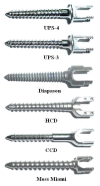Comparison and prediction of pullout strength of conical and cylindrical pedicle screws within synthetic bone
- PMID: 19402917
- PMCID: PMC2694760
- DOI: 10.1186/1471-2474-10-44
Comparison and prediction of pullout strength of conical and cylindrical pedicle screws within synthetic bone
Abstract
Background: This study was designed to derive the theoretical formulae to predict the pullout strength of pedicle screws with an inconstant outer and/or inner diameter distribution (conical screws). For the transpedicular fixation, one of the failure modes is the screw loosening from the vertebral bone. Hence, various kinds of pedicle screws have been evaluated to measure the pullout strength using synthetic and cadaveric bone as specimens. In the literature, the Chapman's formula has been widely proposed to predict the pullout strength of screws with constant outer and inner diameters (cylindrical screws).
Methods: This study formulated the pullout strength of the conical and cylindrical screws as the functions of material, screw, and surgery factors. The predicted pullout strength of each screw was compared to the experimentally measured data. Synthetic bones were used to standardize the material properties of the specimen and provide observation of the loosening mechanism of the bone/screw construct.
Results: The predicted data from the new formulae were better correlated with the mean pullout strength of both the cylindrical and conical screws within an average error of 5.0% and R2 = 0.93. On the other hand, the average error and R2 value of the literature formula were as high as -32.3% and -0.26, respectively.
Conclusion: The pullout strength of the pedicle screws was the functions of bone strength, screw design, and pilot hole. The close correlation between the measured and predicted pullout strength validated the value of the new formulae, so as avoid repeating experimental tests.
Figures






References
Publication types
MeSH terms
LinkOut - more resources
Full Text Sources

